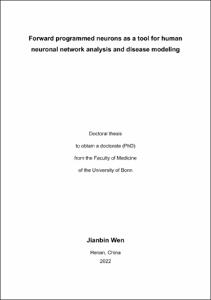Forward programmed neurons as a tool for human neuronal network analysis and disease modeling

Forward programmed neurons as a tool for human neuronal network analysis and disease modeling

| dc.contributor.advisor | Brüstle, Oliver | |
| dc.contributor.author | Wen, Jianbin | |
| dc.date.accessioned | 2022-02-08T13:55:29Z | |
| dc.date.available | 2022-02-08T13:55:29Z | |
| dc.date.issued | 08.02.2022 | |
| dc.identifier.uri | https://hdl.handle.net/20.500.11811/9602 | |
| dc.description.abstract | Introduction: Forward programming enables the generation of highly pure excitatory and inhibitory neurons from human pluripotent stem cells (hPSCs). This study is to establish and functionally characterize forward programmed in vitro neuronal cultures derived from hPSCs, and explore their potentialities in modeling neural network development, neural stimulation, and brain diseases including epilepsy and psychiatric disorders. Method: Excitatory and inhibitory human neurons were generated by forward programming human hPSCs carrying the inducible transcription factors NGN2 and ASCL1/DLX2 expression cassettes, respectively. These neurons were cultured with defined compositions on multi-electrode arrays (MEAs) for electrophysiological measurements on a network level. In parallel, in silico neuronal network models fed with neuronal parameters obtained from the in vitro cultures were developed to explore potential mechanisms underlying the experimental observations with MEAs. In addition, as an exemplar, this study focuses on a gene that has been associated with psychiatric disorders: RB1CC1. For this, hPSC lines were subjected to CRISPR-Cas9 mediated genome editing to introduce loss-of-function mutations into the RB1CC1 gene. This study then focused on the phenotypic characteristics of neurons derived from the isogenic cell lines, including molecular, morphological, and electrophysiological alterations due to RB1CC1 loss of function. Results: Firstly, the electrophysiological properties of the obtained neuronal networks were systematically characterized with multi-electrode arrays. In silico computational models were able to reproduce key experimental observations, including network bursts and expected response to simulated synaptic modulations. Secondly, a seizure-like nested network activity observed in highly pure glutamatergic neuronal cultures was described. In-depth in vitro exploration of this phenomenon combined with in silico simulation resulted in a novel theoretical framework of epileptiform activities observed in human neuronal cultures, which was characterized by pure excitatory composition, unstructured network organization, and a hierarchy of presynaptic vesicle pools. Thirdly, neurons lacking RB1CC1 showed autophagy deficiency and pathological axonal swellings, a phenomenon that could be partially phenocopied with an ULK1/2-specific autophagy inhibitor in control cells. RB1CC1-deficiency resulted in a hyperactive network. Pharmacological inhibition of focal adhesion kinase signaling could normalize the hyperactivity of RB1CC1-deficient neurons, whereas inhibition of autophagy in control neurons led to hyperactivity. These results suggest that both impaired autophagy and disinhibition of FAK contribute to the hyperactivity phenotype of RB1CC1-deficient neuronal networks. Conclusion: Forward programmed human neuron is a highly controlled and versatile tool for neural network analysis and brain disease modeling. | en |
| dc.language.iso | eng | |
| dc.rights | In Copyright | |
| dc.rights.uri | http://rightsstatements.org/vocab/InC/1.0/ | |
| dc.subject | Vorwärtsprogrammierung | |
| dc.subject | menschliche pluripotente Stammzelle | |
| dc.subject | Multi-Elektroden-Array | |
| dc.subject | neurale Stimulation | |
| dc.subject | Neurales Computernetz | |
| dc.subject | epileptischer Anfall | |
| dc.subject | psychiatrische Erkrankung | |
| dc.subject | Autophagie | |
| dc.subject | Forward programming | |
| dc.subject | human pluripotent stem cell | |
| dc.subject | multi-electrode array | |
| dc.subject | neural stimulation | |
| dc.subject | computational neural network | |
| dc.subject | epileptic seizure | |
| dc.subject | psychiatric disease | |
| dc.subject | autophagy | |
| dc.subject.ddc | 610 Medizin, Gesundheit | |
| dc.title | Forward programmed neurons as a tool for human neuronal network analysis and disease modeling | |
| dc.type | Dissertation oder Habilitation | |
| dc.publisher.name | Universitäts- und Landesbibliothek Bonn | |
| dc.publisher.location | Bonn | |
| dc.rights.accessRights | openAccess | |
| dc.identifier.urn | https://nbn-resolving.org/urn:nbn:de:hbz:5-65488 | |
| ulbbn.pubtype | Erstveröffentlichung | |
| ulbbnediss.affiliation.name | Rheinische Friedrich-Wilhelms-Universität Bonn | |
| ulbbnediss.affiliation.location | Bonn | |
| ulbbnediss.thesis.level | Dissertation | |
| ulbbnediss.dissID | 6548 | |
| ulbbnediss.date.accepted | 01.02.2022 | |
| ulbbnediss.institute | Medizinische Fakultät / Institute : Institut für Rekonstruktive Neurobiologie (IRN) | |
| ulbbnediss.fakultaet | Medizinische Fakultät | |
| dc.contributor.coReferee | Witke, Walter | |
| ulbbnediss.contributor.gnd | 1255076623 | |
| ulbbnediss.contributor.gnd | 1255076623 |
Files in this item
This item appears in the following Collection(s)
-
E-Dissertationen (1616)




